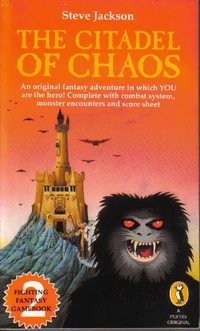 Fighting Fantasy Gamebooks were what got me into tabletop roleplaying games. I started with book 2 – ‘The Citadel Of Chaos’ – and played it to death. I’ve still got it, the cover all faded and the pages yellowed with age, the spine heavily creased and the centre of the pages smudged and marked by all the thumb-flipping I did. I was hooked on these books all the way through the 1980s, and when I couldn’t get a tabletop RPG on I’d turn to my gamebooks for my fix. I bought them all, even the ‘Sorcery!’ series and ‘The Clash of the Princes’.
Fighting Fantasy Gamebooks were what got me into tabletop roleplaying games. I started with book 2 – ‘The Citadel Of Chaos’ – and played it to death. I’ve still got it, the cover all faded and the pages yellowed with age, the spine heavily creased and the centre of the pages smudged and marked by all the thumb-flipping I did. I was hooked on these books all the way through the 1980s, and when I couldn’t get a tabletop RPG on I’d turn to my gamebooks for my fix. I bought them all, even the ‘Sorcery!’ series and ‘The Clash of the Princes’.The gamebooks also gave rise to the introductory roleplaying ‘Fighting Fantasy’ and I have used this system to introduce new players to the hobby more than once. It’s not a great system. In fact, the later RPG editions that called themselves Advanced Fighting Fantasy were in fact a little broke, but for a beginning game it was perfect. The system has now been smoothed out and improved upon by Arion Games.
The adventurers statistics, just as in the gamebook, were SKILL, STAMINA and LUCK. Skill and Luck were a number from 6 to 12 whereas Stamina (hit points, basically) was a score up to 24. Using two six-sided dice the game could progress at a tremendously fast pace. All that was required during combat was a single roll of 2D6 which would determine who won the round. Some actions were determined by the Skill level and a single D6 was used for other actions, a target number between 1 and 6 chosen by the GM depending on the difficulty of the situation. Luck could save a character’s life and help them out of sticky situations.
It’s a perfectly simple system. The dice rolls were simple and you could resolve a battle with even a large group of characters in minutes. There were hardly any charts or tables to peruse and everything a player needed was listed on single sheet. Pure simplicity and a rules-light fan’s dream.
To accompany the system was a vast world that had been created and explored throughout the Fighting Fantasy gamebooks – Titan. Three continents covered a diverse range of lands, races and cultures. You could play the equivalent of a historical European Knight, a Samurai, a Pirate, a Viking… the choice was fantastic. There were monsters and bad guys crawling out of every corner of the world and it had a detailed history. Two books, ‘Titan- The Fighting Fantasy World’ and ‘Out of the Pit’ were filled with details, histories, monsters and locations and could keep you in games and adventures for weeks. There was certainly plenty of material to use and abuse.
 The great thing about the system is that you can take one of the gamebooks and use that as your setting, not just the Titan world. If I wanted spaceships I’d haul out my copy of ‘Starship Traveller’ and use the spaceship rules in there. Mad Max game? ‘Freeway Fighter’ fits the bill. The gamebooks could act as little scenarios/sourcebooks in their own right.
The great thing about the system is that you can take one of the gamebooks and use that as your setting, not just the Titan world. If I wanted spaceships I’d haul out my copy of ‘Starship Traveller’ and use the spaceship rules in there. Mad Max game? ‘Freeway Fighter’ fits the bill. The gamebooks could act as little scenarios/sourcebooks in their own right.Titan, and especially the primary continent of Allansia, was ripe for plenty of high-fantasy adventuring yet the system itself did not really lend itself to long-term play. You could play characters for a long time but the limitations of the system did not really allow for advancement. What little advancement there was ended up being restricted by the system. Fighting Fantasy worked excellent as an introductory game but it was mainly a stepping stone on to other more detailed RPG games and systems. The world of Titan is an excellent place to adventure and rivals many of the worlds created for modern games, but it needs a system that suits it and allows for character advancement. The Fighting Fantasy rules are perfect for introducing new blood and they have a huge gaming world for budding new players to run around in, but I can’t help but think that the system is nothing but basic training before new gamers go out and discover newer and better RPGs.
I still love it, though. I love the simplicity and it allows me to explain how game mechanics work in a rolepaying game without scaring anyone away. I’m not wielding a huge scary 600-page tome of comprehensive rules, I’ve got a little paperback with which to ease new players into the game. I’ll continue to use the Fighting Fantasy rules for new players, especially the younger ones, and I can highly recommend that anyone thinking of doing the same thing use these rules.
They've now been re-released by Scholastic, with new layouts and new artwork, so a whole new generation of gamers are there, waiting in the wings, and what better way to get them into the tabletop roleplaying than with a game of Fighting Fantasy - The Introductory Roleplaying Game.

No comments:
Post a Comment